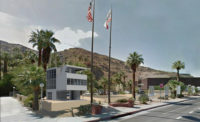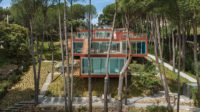Moshe Safdie was nibbling crab cakes in the recently completed, 150,000-square-foot glass-and-concrete headquarters he designed for the United States Institute of Peace in Washington, D.C. It was a silver October day, and lunch was served in a boardroom overlooking the Lincoln Memorial, Washington Monument, and Capitol building. “These are great views,” Safdie noted, “and we made the most of them.”
The commanding 73-year-old architect had just finished leading a tour of the institute, which had, indeed, scored prime real estate: the last buildable site available on the National Mall—a former parking lot on the northwest corner. Capitalizing on the surroundings, Safdie conceived a building with atria and offices filled with light, thanks to glass curtain walls and a billowing roof made of 1,482 glass panels.
Created by Congress in 1984, the institute is a nonpartisan organization whose mission is to help prevent and resolve international violent conflicts. For years, its roughly 325 employees worked in rented space in a nondescript office building, with no common area where they could host dignitaries and other visitors.
In 2001, the institute launched a design competition for a new headquarters. In December of that year, it awarded the commission to Safdie, who beat out four other finalists: Pelli Clarke Pelli Architects, Michael Graves and Associates, Polshek Partnership (now Ennead Architects), and Weiss/Manfredi (which withdrew). Prior to the call for entries, Safdie had never heard of the institute. “I couldn’t figure out how such an important institution was not a known quantity,” he says. The organization’s president, Richard H. Solomon, says Safdie’s scheme was chosen because the other proposals “were basically square buildings.”
Safdie’s five-story structure is blocky in shape, but it is topped by a sculptural roof whose two pointed wings cantilever over the heavy massing of the acid-etched precast-concrete building. In conceiving the roof, Safdie began with a series of fluid forms, “like a flock of birds,” but the end result evokes a geometric sketch of a single bird’s outstretched wings. Safdie says he’s “not one who believes in overt symbolism,” yet it’s hard not to think of doves, the symbol of peace, when gazing at the roof. The 8-inch-thick roof consists of layers of glass set in a steel tube grid.
In addition to creating a pleasant workplace, Safdie wanted to entice the public to wander into the new building. To achieve this he inserted two large atria. One faces the Lincoln Memorial, with an entrance on busy Constitution Avenue. Offices overlook the atrium through window-walls and, in turn, allow visitors glimpses of the inner workings of the institute. A smaller atrium, with an employee entry on Twenty-Third Street, looks toward the Potomac River. Again, glazed rooms overlook the space; at ground level, employees can be seen sitting at patio tables.
The headquarters also includes a 20,000-square-foot Global Peacebuilding Center, a new public education initiative containing touch-screen kiosks, a resource center, and classrooms. It will be completed over the next few years.
Phase one of the $186 million institute was finished in October, less than three years after construction began. A grand opening is set for later this year.
Safdie has been busy. He has three other projects finishing up this fall: the Kauffman Center for the Performing Arts in Kansas City, Missouri; the Crystal Bridges Museum of American Art in Bentonville, Arkansas (read our recent coverage); and the Khalsa Heritage Centre in Anandpur Sahib, India. The institute, despite its prominent location, hasn’t received the same anticipatory fanfare as Crystal Bridges, funded by Walmart heiress Alice Walton. Compared to Crystal Bridges’ eight pavilions set around two ponds, the institute seems less contrived.
The roof is the building’s big symbolic gesture—and Safdie agonized over it. For those who work inside the light-filled building, his angst paid off. (During the recent tour, Robin Wright, an institute fellow and author of the new book Rock the Casbah, gushed to Safdie, “I love your building. You bring me closer to God.”) For those who never wander indoors, however, the exterior seems too referential to the heavy classicism of its monumental neighbors. It leaves one wishing Safdie had focused on more than the building’s ethereal crown.












Post a comment to this article
Report Abusive Comment